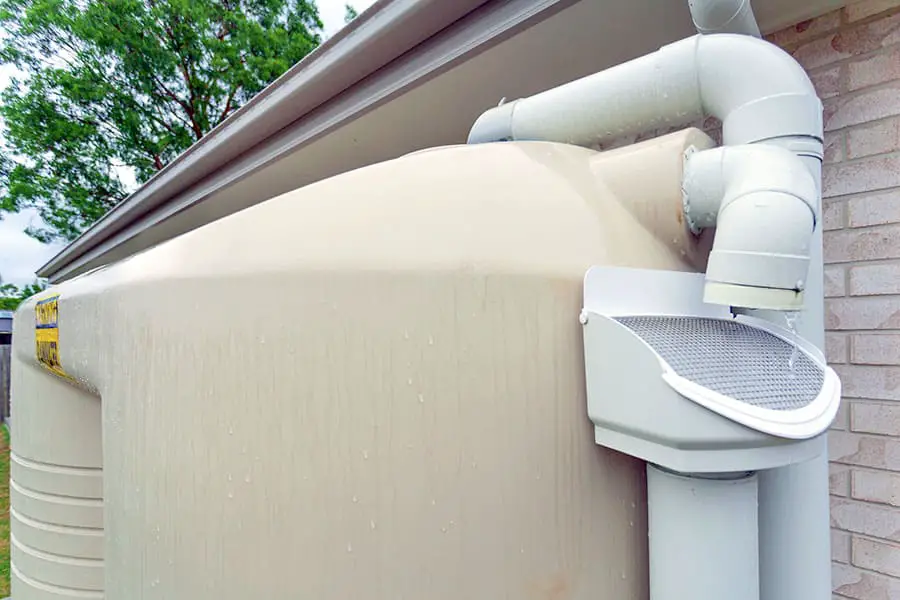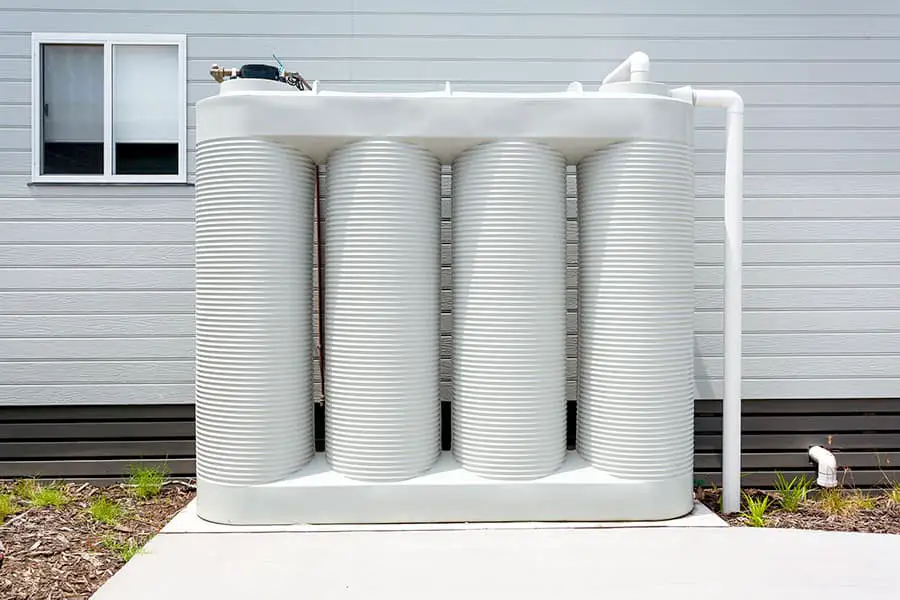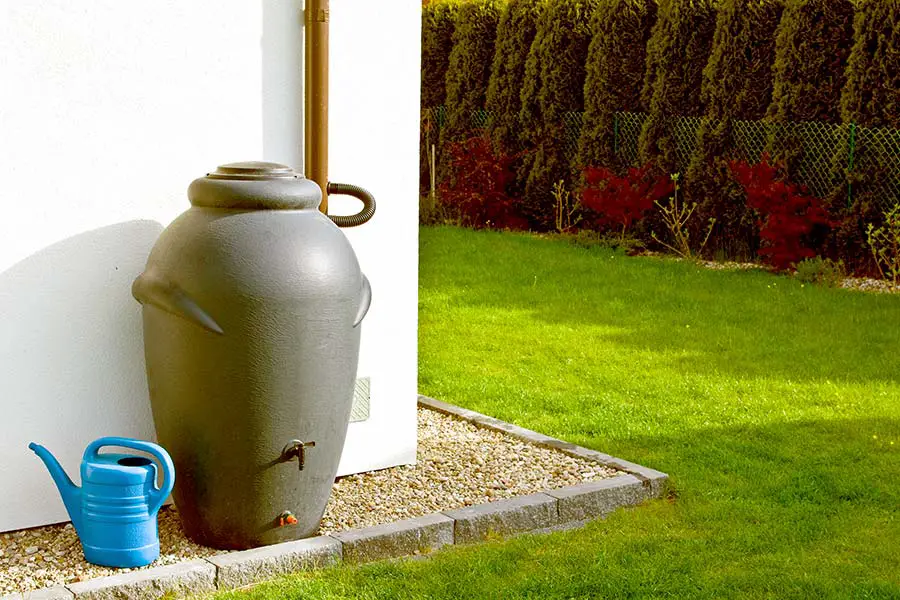
In recent years, California has received international attention for its severe droughts and massive wildfires. Much of this is a result of decreased rainfall. Unfortunately, the rain that does fall on the Golden State goes mostly unused as it flows down rivers and into the Pacific Ocean. The state’s residents are open to new methods of using this “liquid gold.” But is it illegal to collect rainwater in California?
Rainwater collection is perfectly legal in California as of 2012 when the state legislature passed a law allowing homeowners to collect rainwater for non-potable uses around their property. These uses include watering lawns and gardens and cleaning vehicles and farm equipment.
If you are considering installing a rain collection system on your property, you want to make sure you get up to speed on the current regulations, as these do change over time. In this post, we’ll cover what types of rainwater collection systems are permitted, how the water can be used, and ways to keep your family and community safe from harmful water storage practices.
Rainwater: Can You Collect it in California?
The State of California is famous for lots of sunny days and having long periods without rain. Unfortunately, this sunny weather often leads to very dry conditions that result in extreme situations like drought and wildfires.
The last statewide drought (from 2012 to 2016) lasted four years, impacting every county in the state. While rain levels have improved some since then, regional water shortages remain. In addition, each year, wildfires seem to get worse as more significant and more severe fires ravage the California landscape.

Fortunately, California has loosened restrictions in recent years to allow homeowners to capture rainwater to use on their properties. In 2012, Assembly Bill 1750 (named the Rainwater Capture Act of 2012) was passed by the California State Legislature. This bill helped to reduce the stress on public water supplies during the drought and continues to be beneficial today.
Under the Water Code (section 1201), the Board is authorized to dictate the use of water that flows in natural channels. However, the State determined that rooftops are not a natural channel and therefore did not apply to the Water Code.
This decision opened the door for the Rainwater Capture Act. Under the Act, homeowners can collect rainwater legally as long as they follow the requirements that are enforced by the California State Water Resources Board.
The Act dictates that water used for drinking or human consumption (also referred to as potable water) must come from municipal or other approved sources (like a freshwater well). However, the Rainwater Collection Act permits rainwater to be collected for a variety of non-potable activities, including:
- Watering Lawns, Gardens, and Houseplants – Water irrigation systems for lawns and home gardens can be fed with natural rainwater. The Act does dictate that a licensed landscape contractor must construct this system. The exception would be if you left buckets out during a rainstorm to collect water to use for houseplants.
- Pools, Ponds, and Fountains – Water features around your property can be hooked up to rainwater collection systems. These must also be installed or built by a licensed contractor or landscaping professional.
- Drinking-Water for Pets or Livestock – In addition to giving your pets and livestock a drink, you can also use rainwater to fill up your birdbath.
- Washing Vehicles or Farm Equipment – Washing vehicles use a lot of water. Rainwater is a great option when it comes to washing your cars, trucks, motorcycles, bikes, or farm equipment.
- Fire Protection – There have been numerous stories in the news of homeowners using a garden hose to protect their property from a raging wildfire. Having a rainwater storage system can provide an abundant supply of water for fire protection.
- Other Household Uses – Any household activity that doesn’t involve ingestion of rainwater can be considered, including flushing toilets, cleaning floors, and washing decks.
Bay Area Answers Fun Fact: The record rainfall in California occurred in January of 1943 in the San Gabriel Mountains. In 24 hours, the area was drenched with 25.83 inches of rain.
Most cities are very friendly when it comes to rainwater collection. Some, like San Diego, even go as far as offering incentives or rebates to homeowners who install rain collection systems.
While there are generally few restrictions on collecting rainwater from city or county officials, you might face opposition from your Homeowners Association (HOA). These restrictions are usually based on aesthetics (like a rain barrel visible from the street), so check out your HOA’s bylaws for more information.

The bylaws could dictate the location, size, type, and even color of rainwater collection barrels. However, because of recent droughts and increased environmental awareness, more HOA’s and association managers are getting on board with loosening these types of restrictions and making their communities more eco-friendly.
Other Posts of Interest
- What Cities Are Affected By The Santa Ana Winds?
- Which Channel Island Is Best for Camping?
- Is Gold Still Found in California?
- Does Citrus Grow in the Bay Area? (Best Varieties to Plant)
How Do You Harvest Rainwater?
There are many ways to collect rainwater on your property. Some people choose to simply set out buckets when rain is on the forecast (a kid-size swimming pool works like a charm). Others have very complex systems where rain barrels or underground storage tanks are connected to the home’s gutter system.
Whether you hire someone to install a rainwater collection system or build it yourself, pay close attention to the manufacturer’s guidelines and warnings. For best results, you should check with a specialist to avoid any unhealthy consequences. For example, sitting water left exposed to the open air for extended periods of time can attract mosquitoes or promote the growth of harmful bacteria.
Rain barrels on the market are made from a wide variety of materials, including stone, ceramic, clay, wood, and plastic. The key is to select one that has the following components:
- Mesh or Screened Inlet – This helps to filter water as it goes into the barrel and blocks debris such as leaves, seeds, and mosquito larvae.
- Removable Lid – A removable lid allows you to open the top for easy access and the ability to clean the barrel thoroughly periodically.
- Overflow Valves – From time to time, California can experience high volumes of rain (especially during El Niño). Your barrels can quickly fill up, so you want to have an overflow to prevent water from backing up your gutter system.
- Water Spigot – A spigot near the bottom of the barrel will give you access to the water and allow for a garden hose to be attached.
Does Rainwater Harvesting Save Money?
Collecting rainwater can save you a lot of money throughout the year since you don’t need to buy it from your local water authority. In California, the average family will spend approximately $65 each month on just water. A 20 percent reduction in public water use can easily save $150 to $200 in a year. The amount of cash you can save will depend on the type and size of your rainwater collection system.

Any opportunity to use rainwater instead of municipal water will ultimately reduce your water bill. Think about all the non-potable water uses that you can replace with rainwater.
Why is Rainwater so Dirty?
Many people make the error of believing that water that falls from the sky is in its purest and most clean form. Unfortunately, this is untrue. Although rain is natural, it can carry harmful bacteria.
For this reason, you should avoid drinking or ingesting rainwater to prevent the potential for illness or disease. Also, even if rainwater is free from bacteria, it can pick up other contaminants such as dust, smoke, and pollen as it falls from the sky.
In addition, if you are collecting the rainwater from your roof, it may contain tiny particles from the shingles or other roof coverings, decomposing leaves, and other debris.
How Much Rainwater Can You Collect in California?
The State of California does not regulate the number of gallons of rainwater that homeowners can collect as long as there are no threats to public health (such as a mosquito breeding ground). However, the size of your roof can determine the amount of rain that you can collect.
As a general rule of thumb, a 1000 square foot roof can generate about 625 gallons of water for each inch of rain. Based on this, you can decide what size rainwater collection system you might need.
Making the Best Use of California’s Natural Resources
It’s estimated that trillions of gallons of rainwater each year go unused in California alone. This very precious resource is ours to leverage and use. While the Rainwater Collection Act does grant general permission to collect rainwater, you should check with your local governing water authority, city, or HOA to see if there are any special restrictions or requirements for your area. Checking will ensure that you don’t install a system that will result in a fine or be required to remove.





